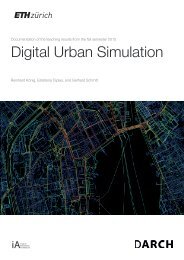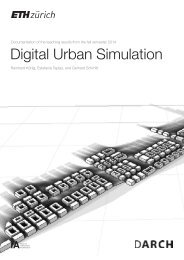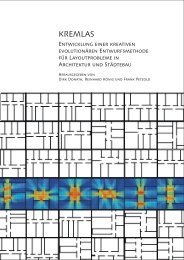New methods in urban analysis and simulation
Documentation of teaching results from the spring semester 2015 of the seminar Digital Urban Simulation at the Chair of Information Architecture, ETH Zurich
Documentation of teaching results from the spring semester 2015 of the seminar Digital Urban Simulation at the Chair of Information Architecture, ETH Zurich
Create successful ePaper yourself
Turn your PDF publications into a flip-book with our unique Google optimized e-Paper software.
3<br />
< axial <strong>analysis</strong> current ><br />
In this <strong>analysis</strong> I looked at how the current site<br />
behaves as an open space. This space is a closed<br />
space <strong>and</strong> is not used by the public. However, If<br />
it is an open space to the public its characteristics<br />
changes significantly.<br />
The “<strong>in</strong>tegration [HH]” – show how each street is<br />
connected to all others <strong>in</strong> terms of the maximum<br />
possible directio changes. The current space is<br />
highly <strong>in</strong>tegrated <strong>and</strong> already connected well with<br />
the surround<strong>in</strong>g network. It is a prime location by<br />
this <strong>analysis</strong>. The isovist <strong>analysis</strong> also conforms<br />
that this site is located at a prime location for use<br />
as public space.<br />
Once its stance as a suitable site to build a new<br />
public space is established, how is it possible to<br />
determ<strong>in</strong>e what k<strong>in</strong>ds of forms exemplify its qualities<br />
while also draw<strong>in</strong>g <strong>in</strong> pedestrian traffic to the<br />
proposed market space?<br />
AXIAL ANALYSIS-CURRENT<br />
<strong>New</strong> Methods <strong>in</strong> Urban Analysis <strong>and</strong> Simulation I<br />
36








